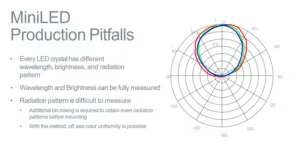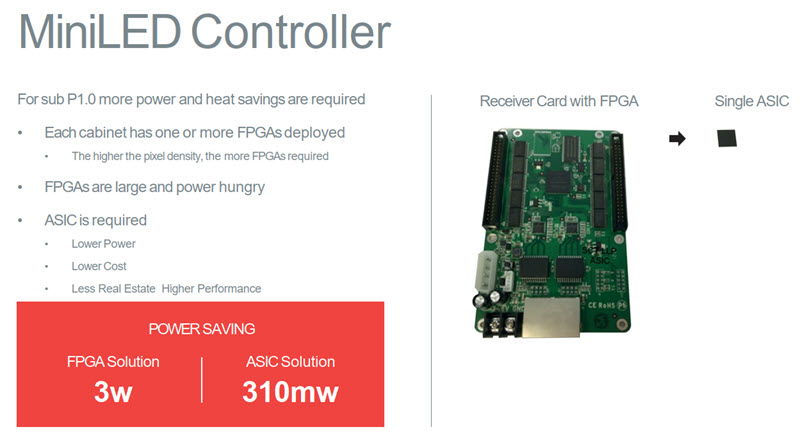Eric Li of Silicon Core took the floor in the Yole webinar to talk about direct view miniLED displays. He is a developer of some of the best looking narrow pitch direct view displays over recent years and his firm was a pioneer of common cathode technology.

Li started by defining what he means by miniLED with sizes from 50?m to 250?m which are currently positioned using pick and place, although mass transfer could be introduced as the market transitions to microLED. He pointed out that miniLED is more energy efficient than traditional wire bonded LEDs. Manufacturing is less complex than with wire bonded LEDs and the savings from no wire can offset the extra cost of flip-chip designs. Like Virey, he described the “Integrated Multi Device” (IMD) and “MicroLED in Package” concepts as well as COB/COG.
The better pricing and efficiency should open up new markets. However, as miniLEDs get smaller it can be harder to make them with robust connections and this gets a lot harder below 50?m. Li believes that mass transfer processing and the use of glass substrates will be necessary for FURTHER reducing costs and for higher production speed. At the moment, though, pick and place with PCBs is the most reliable way to make the displays.
Radiation Patterns are a Challenge
However, there are challenges when you buy LEDs. Everybody knows that there are differences in wavelength and brightness, but these can be measured. However, there are also differences in radiation pattern and that is very difficult to measure, but needs to be taken into account to make good displays. It is not possible to measure every LED, so there have to be methods to randomise the viewing angle performance to get good image quality and especially off-axis colour uniformity. Li sees this as one of the biggest current challenges with miniLED use.
(I have been tracking this technology for many years and this is the first time I have heard someone talking about this challenge – it’s never too late to learn! Editor)
In the longer term, Li believes, you have to be able to mount the LED directly on the substrate without using pick and place methods if you want to get the cost down.
Heat is a Challenge for Drivers
Turning to the drivers, a key point is controlling the heat generated by the LEDs. He believes that miniLED has to be driven by a common cathode system as common anode runs too hot. This becomes critical at pitches below 1.0mm. Power consumption is a key factor and the controller is important there. Unfortunately, the FPGAs that are often deployed (typically one card per cabinet) are large and power hungry and really need to be replaced with ASICs. That can bring power down from 3W to 310mW as well as reducing the real estate used on the back of the display. That’s important as the FPGA can be taking between 25% and 50% of the total power of the cabinet at pitches below 1mm. Silicon Core is trying to develop the ASICs.
Looking at applications, miniLED has become popular for many commercial applications, although it is still too expensive for consumers. Silicon Core believes that the next target market should be outdoor LCD systems, where LCD sees some challenges in power consumption and running costs. The long life can mean that the total cost of ownership (TCO) can be lower for miniLED than for LCD, even though the initial cost may be higher. There are other advantages including more flexible shapes and better brightness.
Direct view LED is already challenging projection in very large displays.
Questions
There were lots of questions after the webinar. The first was about LCD backlights and the ‘typical’ supply chain. Virey responded that there really is no single ‘typical’ model. Samsung has a very vertically integrated supply chain but Apple has entirely ‘externalised’ its supply chain. It is controlling the whole process, but is contracting out everything from chip-making and assembly to testing. That means that there can be a lot of ‘margin stacking’. In China, the top of the range may be made in-house, but backlights for lower quality, sets may be sub-contracted.
On the question of viewing angle binning, you need to really mix the radiation patterns to ensure an even response, Silicon Core said.
In response to another question, Li said that the speed of pick and place has really improved in recent years but it’s not the dominant cost – at the moment, it’s the chip itself. It may become more of an issue if the chips get cheaper and the pick and place cost becomes a more important part of the total cost.
Virey said that there is a lot of work being done to develop specific machines that could deposit 150K – 300K packages in an hour – which would be around 10X the speed of just a couple of years ago.
Responding to a question about LCD makers coming into the LED space, Virey said that increasingly firms are trying to replace circuit boards plus discrete driver chips with active matrix substrates. He said that he thought that BOE is trying hard to move to this. It has a glass backplane, but he doesn’t think it is using an active matrix. Silicon Core said that it had seen demoes of chip-on-glass with active substrates from Samsung and BOE who are both getting more interested in this approach. Li said that for very large screens, active matrix may have challenges but for consumer TV sizes, they could be useful. They may also not have enough power to drive high brightness. However, if miniLEDs get cheaper in three to five years, it could be a good approach.
Conclusion
Overall, this was a really valuable seminar that summarised and clarified a lot. Well done, Yole and Silicon Core! (BR)


